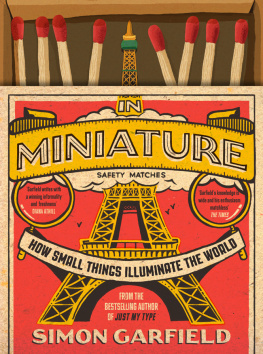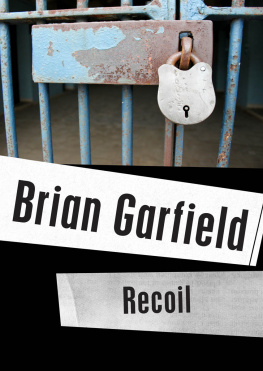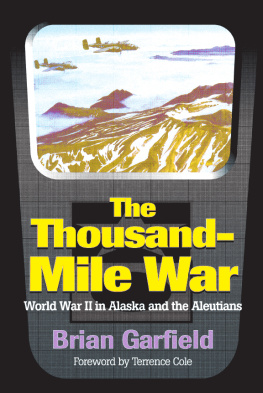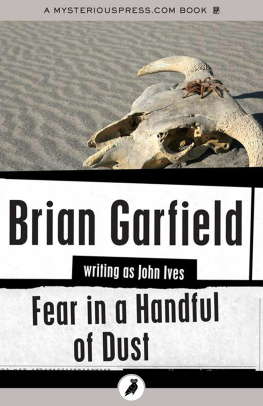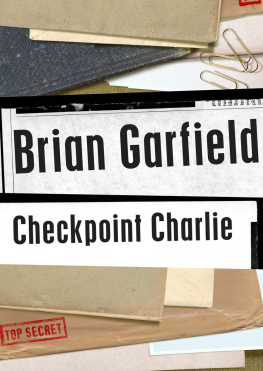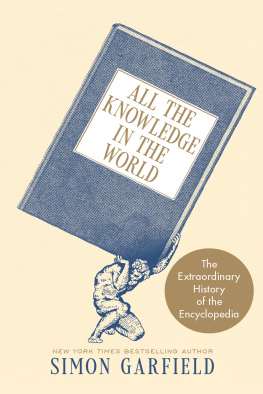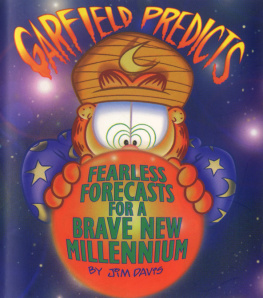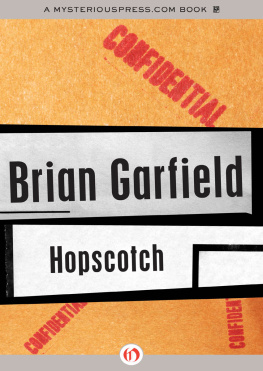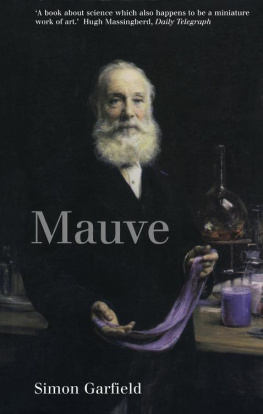
Also by Simon Garfield
Expensive Habits
The End of Innocence
The Wrestling
The Nations Favourite
Mauve
The Last Journey of William Huskisson
Our Hidden Lives (ed.)
We Are at War (ed.)
Private Battles (ed.)
The Error World
Mini
Exposure
Just My Type
On the Map
To the Letter
My Dear Bessie (ed.)
A Notable Woman (ed.)
Timekeepers

First published in Great Britain in 2018
by Canongate Books Ltd, 14 High Street, Edinburgh EH1 1TE
canongate.co.uk
This digital edition first published in 2018 by Canongate Books
Copyright 2018 Simon Garfield
The moral right of the author has been asserted
For picture credits, see
A Vision copyright Simon Armitage (Tyrannosaurus Rex versus the Corduroy Kid, 2006), reproduced by permission of Faber & Faber Ltd and David Godwin
British Library Cataloguing-in-Publication Data
A catalogue record for this book is available on request from the British Library
ISBN 978 1 78689 077 1
eISBN 978 1 78689 078 8
Typeset in Adobe Caslon Pro by
Palimpsest Book Production Ltd, Falkirk, Stirlingshire
For Justine
By doing something a half centimetre high, you are more likely to get a sense of the universe than if you try to do the whole sky.
Alberto Giacometti
The only thing that gets better when it gets bigger is a penis.
George Lois
Contents
The presence and importance of the miniature in our lives, and how it enriches our appreciation of the world.
How the Eiffel Tower transformed our understanding of the city and popularised the souvenir.
How the model fixes forever a nations vision of itself.
And how miniature painting laid it bare.
How big is the smallest book in the world, and how in the world do you open it?
What Queen Marys charming dolls house has in common with Frances Glessner Lees unnerving crime scenes.
And why Rod Stewart and Neil Young keep laying down new tracks.
Reshaping the landscape one model at a time.
A stationer with an interest in matchsticks tests the limits of an obsession.
Angels in America in a box.
The champions of the micro-miniature, and the curiously addictive world of tiny food.
The case of the vanishing Prussians, and how it feels to be 8 inches tall and sandstone.
List of Illustrations

Introduction
The Art of Seeing
Not so long ago, bigness was the thing. A big pack was better value. The department store had more of everything, as did Texas. Encyclopaedia Britannica had all the knowledge and occupied one-sixth of all available living-room shelving.
Then small was beautiful. The toy poodle. The Mini. The boutique. Nouvelle cuisine. The exclusive club. The stacking chair.
And then, in the age of technology, even smaller was all: the microchip, the microwave oven, the in-ear headphone, 1,000 songs in your pocket, the nanosecond, the slider.
A while after that which brings us to now things are confusingly big again. The flat-screen television. The Airbus A380. The intractable size of our global economic and security dilemmas. Dwayne Johnson.
Size is one thing, but scale is another, and this book is about scale. It is specifically concerned with how the miniature world informs the world at large. At its heart it is a book about looking, and about seeing; and with this may come elucidation. We bring things down to size to understand and appreciate them. Something too big to visualise at full scale a building perhaps, or a war may be rendered comprehensible at 12:1. Artists sculptors, set designers, poets work in miniature because it encourages greater scrutiny and deeper participation, and I hope this book will do the same.
This is also a book about pleasure and vision a celebration. Miniature items help us imagine grander schemes. A signal box on a model railway is eyed with needling precision, and with the care we would seldom apportion to one at full size. Before we landed on the Moon, at least one NASA scientist clung for inspiration, through difficult times, to the marionettes and rockets on the British television series Thunderbirds. Architects of future cities must first scheme in model form, and the model may be the only proof that they attempted such a thing.
Of all the miniature things well encounter in the following pages, not all of them will be small. The miniature railway in Hamburg prides itself on being the biggest in the world. The Venetian hotel in Las Vegas, with its fully workable gondola rides for the romantically obtuse, sleeps 4,000. But everything here will be miniature in scale, compared to the thing its a miniature of.
The word miniature derives from the world of books, but it was popularised by the world of art. Before the printing press, when books were written by scribes and illustrated by hand, the word evolved from the Italian word miniatura, which itself derived from the Latin miniare, to colour with red lead. There were very few uses of miniature before the sixteenth century, when the word became associated withillumination in general, and became frequently interchangeable with limning or the painting of small portraits. Thereafter, anything small was referred to as miniature, and the word entered common usage from about 1630. The development of both miniature books and miniature portraits will be examined in later chapters, and both will confirm that it is only with close scrutiny that we may uncover secrets within.
To distinguish between the miniature and the merely small I have adopted a simple qualifier: a miniature must be a reduced version of something that was originally bigger, or led to something bigger, and it should be consciously created as such. It may also perform a miniature duty explain a concept, solve a puzzle, jog a memory. A souvenir of a building on a key ring, though not very interesting, fits the bill. As does a miniature bottle of gin. A Volkswagen Beetle does not, and nor does an ever so small thimble, no matter how keen are those who collect them. Minibars and lapdogs are borderline, as is the art of bonsai cultivation, in which small is created by purposeful pruning and potting. A toy poodle made of plastic in a classroom tableau made by five-year-olds is of no interest to anyone. One could create further rules, and dictate dimensions the way an airline dictates the carry-on, but it will soon become clear that miniatures occupy a significant enough space in our world to create their own instinctual presence: youll know one if you see one, and after a while you may see nothing else.
The miniature world embraces control. The toys we enjoyas children invest us with a rare power at a young age, conferring the potency of adults, and possibly giants. Toy cars and dolls and plastic construction kits are not merely pliable in our hands; they render us conquerors. We may never have such dominion over the world again, unless we continue the play into adulthood. Those men with their train drivers caps and their tiny models in sheds and attics! Their wives long gone! And their wives with their own china madnesses, their little toy families, their smooth hedgehog collections, their treasured things in felt. Who will speak for them? The creation of small universes in which we may bury ourselves to the exclusion of all else will be at the core of this book. The people crouching over tiny details as if the world depended on it are only doing it because their world
Next page
